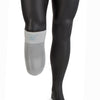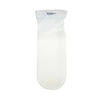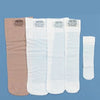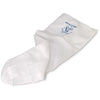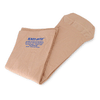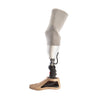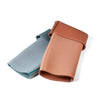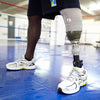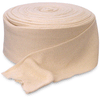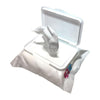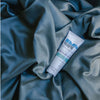15 Skin Problems Amputees Experience & How to Solve Them
Weight, pressure, friction, sweat -- the skin of your residual limb has to withstand a lot!
From time to time, you may find yourself dealing with an uncomfortable situation related to wearing a prosthesis. It's important to be able to recognize what's happening and know what steps to take to address the problem. Read below how to treat these prosthetic related skin issues at home or with the help of your Prosthetist.

1. THE PROBLEM: Dry, flaky skin
Possible Cause(s): Dry skin could be caused by the weather, an irritating product or fabric, or your daily routine (especially if that routine includes very hot showers). Since grafted skin doesn't contain sweat or oil glands, those areas are particularly prone to dryness and cracking.
Possible Solution(s): To relieve itchy, dry skin, add a skin-nourishing prosthetic moisturizer to your daily skin care routine. A thick, creamy formula will soften the skin, keeping it from cracking and drying out again. In the months following surgery, grafted skin should be lubricated daily with mineral oil.
---
2. THE PROBLEM: Skin irritation on the thigh
Possible Cause(s): The top edge of the gel liner and/or sleeve is pulling on the skin of your thigh.
Possible Solution(s): Apply a targeted spot treatment to your thigh, just underneath the end of your liner or sleeve. (Some targeted treatments will last longer than an anti-chafing cream due to their viscosity and special anti-shear ingredients.) Roll your prosthetic liner and bk sleeve on instead of pulling them on.
---
3. THE PROBLEM: Excessive sweating
Possible Cause(s): Amputees have smaller overall skin surface area, which affects the body's ability to cool itself, and because it takes more physical effort to get around, you sweat more in response to physical exertion. In addition to all that, your limb is enclosed under layers of materials, like prosthetic liners, stump sheaths, and prosthetic socks, which don't let cool air reach the skin underneath.
Possible Solution(s): You can't totally eliminate perspiration -- it's part of the body's natural cooling process. But you can invest in a good antiperspirant and sweat control textiles, like a prosthetic sheath or specialized prosthetic sock worn under your foam or gel liner to wick away moisture. If these remedies don't work, you can consider medical options like Botox injections administered by your Physician.
---
4. THE PROBLEM: A skin rash that prickles (heat rash)
Possible Cause(s): Heat rash is caused by sweat trapped in your pores and disrupting the body's regular cooling off activity. A rash tends to appear where skin rubs against skin, such as in skin groin and behind the knees.
Possible Solution(s): The best treatment is to dry off, cool off, and avoid friction on the skin by wearing loose, light weight clothing and using an anti-chafing prosthetic product.
---
5. THE PROBLEM: Contact Dermatitis (red skin, skin bumps, blisters, scales, crusts, or sores)
Possible Cause(s): Contact Dermatitis is a skin rash often caused by an allergic reaction. It may also be brought on by contact with a substance (detergent, skin care product) or material that irritates the skin. Left untreated, dermatitis could lead to chronic inflammation, cellular damage, or cancer.
Possible Solution(s): Cleanse first, then apply anti-itch lotion, barrier cream, and/or topical steroids to soothe the skin. Helpful products like hydrocortisone and zinc oxide can be bought over-the-counter (OTC).
If some component of your prosthesis or skin care routine is causing the allergic reaction, you should ditch the material or the product as soon as possible. Figure out what's causing the reaction through process of elimination. Once you know the source of the irritation and remove it, the problem will most likely go away.
---
6. THE PROBLEM: Small red bumps or white-headed pimples around hair follicles (folliculitis)
Possible Cause(s): Shaving your residual limb or wearing a prosthesis that rubs the skin can irritate the hair follicles, which can lead to folliculitis. Hair follicles are also irritated by sweat buildup. Damaged hair follicles are more susceptible to bacteria, yeast, and other fungi, and so more likely to become infected.
Possible Solution(s): Products called drawing salves, such as ichthammol, can help draw out infection and other objects, including ingrown hairs, from the skin. It's also a good idea to let the hair on your limb grow, rather than shaving it.
---
7. THE PROBLEM: Skin irritation on your knee cap (patella)
Possible Cause(s): The prosthetic liner and/or BK sleeve is pulled too taut over your knee. Or, if redness is occurring along the bottom third of your knee cap, it could be caused by volume loss in your limb.
Possible Solution(s): Use an anti-chafing cream or liquid powder along your knee cap to help your prosthetic liner or below-the-knee sleeve glide on easily. (Tamaracks brand GlideWear product also work especially well.)
Excessive redness along the bottom third of your knee cap is typically the result of insufficient layering of your prosthetic socks. To manage fluctuations in limb volume, start with a one ply or filler sock and continue adding ply until your prosthetic socket fit is comfortably snug. It's not uncommon to experience a good fit along your knee and looseness along the bottom of your liner or sleeve. You may want to consider a half sock to accommodate volume loss along the bottom half of your prosthetic socket.
---
8. THE PROBLEM: Pain, swelling, or leaking along the suture line
Possible Cause(s): Following an amputation, remnants of an absorbable suture that didn't completely dissolve can cause pain, swelling, redness, oozing, separation of the wound, and fever.
Possible Solution(s): A physician can have the remaining suture removed.
---
9. THE PROBLEM: A loose socket fit
Possible Cause(s): If you find that your socket no longer fits like it used to, it's most likely due to a change in the size and shape of your limb. If you've had revision surgery, or have recently gained more than 2 percent of your body weight, the socket won't fit properly and putting it on will be difficult.
Possible Solution(s): In general, you can manage fluctuating socket volume by layering prosthetic socks , wearing a stump shrinker or accommodating volume loss with gel. Maintaining a constant weight is also crucial to maintaining good socket fit. A whole new socket may be necessary if your limb has changed significantly.
---
10. THE PROBLEM: Pain along the inner brim of an Above Knee Prosthetic Socket
Possible Cause(s): Sudden weight gain, especially around the holidays, can create what's called an adductor roll. This extra skin roll sits on top of the inner brim and creates discomfort with every step when it's compressed.
Possible Solutions(s): Try a different technique to apply your prosthesis. Many people have successfully coaxed their adductor rolls inside their sockets using a nylon slip-on aid. Others have used a nylon slip-on aid along with anti-chafing lotion or using a specialized sheath like GlideWear or AK Brim Sheath along the top of your socket. However, if your weight gain is 30lbs or more, a new socket may be warranted. Keep in mind that if adductor rolls are left untreated they may become a permanent fixture on your limb and very difficult for your Prosthetist to reduce with a new socket.
---
11. THE PROBLEM: Skin breakdown caused by constant pressure (pressure sores)
Possible Cause(s): Before amputation, your weight was distributed to various pressure points on the body, like the fat pad of your heel. Now that weight and pressure must be supported by parts of your body not designed for that purpose. Improper prosthetic socket fit can make this worse, further speeding up skin breakdown.
Possible Solution(s): Pressure sores can often be relieved by minor adjustments to your prosthetic interface, but recovery time out of the prosthesis or a whole new socket fit may be necessary. An anti-chafing product or gel pad or strip may help to prevent sores from forming in the future. It's strongly recommended to consult your Certified/Licensed Prosthetist
---
12. THE PROBLEM: Cysts (small bumps or nodules)
Possible Cause(s): After you've worn your prosthetic limb for months or even years, you may notice small bumps or nodules that go away once you've removed the prosthesis. But don't be fooled by this disappearing act -- the underlying problem remains, and the constant rubbing caused by the prosthesis can make the problem worse. Cysts will become larger and more numerous if left untreated. Cysts are a common problem for above-knee amputees (often on the inside of the leg, along the edge of the prosthesis), although below-knee amputees may discover them as well.
Possible Solutions(s): Cysts should always be treated by a doctor before they become infected and cause further damage. It's very important for your Prosthetist to address your socket fit.
---
13. THE PROBLEM: Pain or ulcers from pressure on grafted tissue
Possible Cause(s): Grafted skin doesn't have the added padding of underlying soft tissue nor sweat glands, so it's less able to withstand the constant moisture, pressure, and shearing forces caused by your prosthesis. This is especially true for transtibial amputees (bka).
Possible Solution(s): Make stimulating these sensitive areas with gentle, persistent fingertip massage a part of your daily skincare routine. Gel socket liners or nylon sheaths combined with a thin layer of anti-chafing lotion are also useful for resisting shear force. Sheaths also help with moisture management. Your Prosthetist can make certain socket adjustments to address the problem, but if skin breakdown continues some physicians may suggest a surgical revision as a last resort.
---
14. THE PROBLEM: Invaginated scarring (a deep, healed scar which produces a 'crater' in the flesh)
Possible Cause(s): Invaginated scars result when friction and pressure from the prosthesis cause a wound to fold in on itself during the healing process.
Possible Solution(s): Left alone, these craters in the skin can affect the fit of your liner. They can be filled in with a silicone gel or putty before the liner is pulled on. A custom-made liner that accounts for the crater's shape is another option. Scars that keep coming back may need to be addressed by a dermatologist or a plastic surgeon.
---
15. THE PROBLEM: Closed leaking sores (rough, warty bumps, usually at the far end of your residual limb)
Possible Cause(s): Most likely a condition called verrucous hyperplasia. If the end of your limb and your socket don't make contact -- which is usually caused by weight gain or an ill-fitting socket -- these painful sores are the result.
Possible Solution(s): Call your Prosthetist immediately for a socket re-fitting! In the meantime, try using lambs wool or a distal end pad so that your limb stays in contact with the bottom of your socket.
Not sure if any of these is your issue, or your problem persists after treating it at home? Consult your Licensed/Certified Prosthetist to see whether the problem can be addressed with minor prosthetic adjustments, or whether it's time to see a physician.
Related Articles:
- Alcohol & Skin Care: The Facts
- Do I have a skin disorder?
- How-to create a prosthetic skin care routine?
- How do amputees deal with friction?
- How Does Your Skin Work?
- Ingredients To Avoid
- Know Your Skin Type
- Parabens: Are they really a problem?
- The DOs and DON'Ts of Skin Care
- Why are fragrance free products best?
- Why do some skincare products cause a negative reaction?
- Your Residual Limb Deserves Some TLC
- Common Skin Issues for Above-Knee Amputees














































